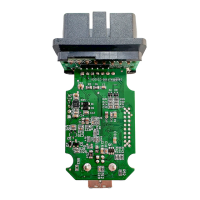USB on-the-go high-speed (OTG_HS) RM0090
1506/1749 RM0090 Rev 18
OTG_HS_HCTSIZ2 = 0, reinitialize the channel for the next transfer. This time, the
application must reset the ODDFRM bit in OTG_HS_HCCHAR2.
• Isochronous OUT transactions
A typical isochronous OUT operation in Slave mode is shown in Figure 424. The
assumptions are:
– The application is attempting to send one packet every frame (up to 1 maximum
packet size), starting with an odd frame. (transfer size = 1 024 bytes).
– The periodic transmit FIFO can hold one packet (1 KB).
– Periodic request queue depth = 4.
The sequence of operations is as follows:
a) Initialize and enable channel 1. The application must set the ODDFRM bit in
OTG_HS_HCCHAR1.
b) Write the first packet for channel 1. For a high-bandwidth isochronous transfer, the
application must write the subsequent packets up to MCNT (maximum number of
packets to be transmitted in the next frame times before switching to another
channel.
c) Along with the last word write of each packet, the OTG_HS host writes an entry to
the periodic request queue.
d) The OTG_HS host attempts to send the OUT token in the next frame (odd).
e) The OTG_HS host generates the XFRC interrupt as soon as the last packet is
transmitted successfully.
f) In response to the XFRC interrupt, reinitialize the channel for the next transfer.
g) Handling nonACK responses

